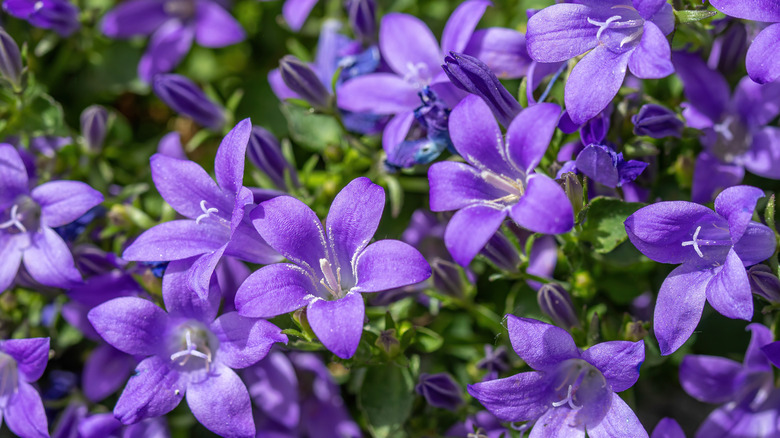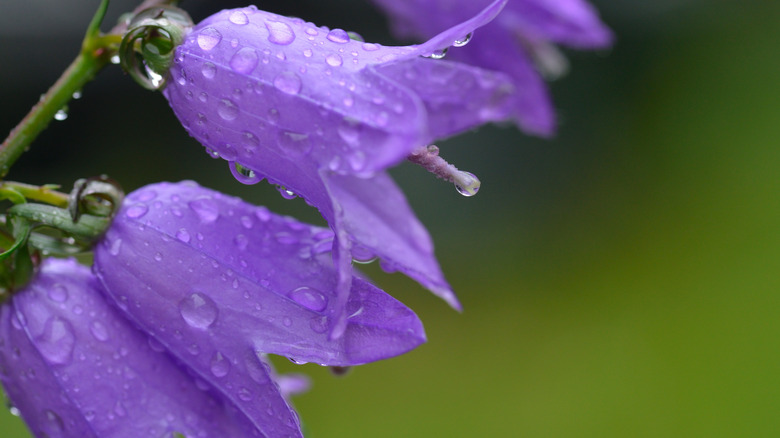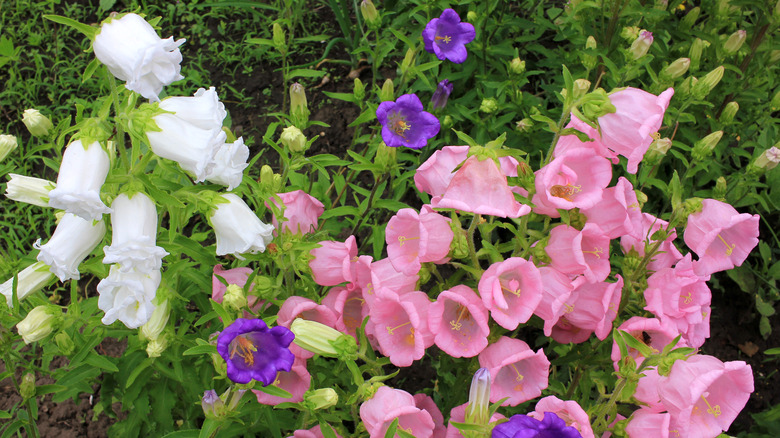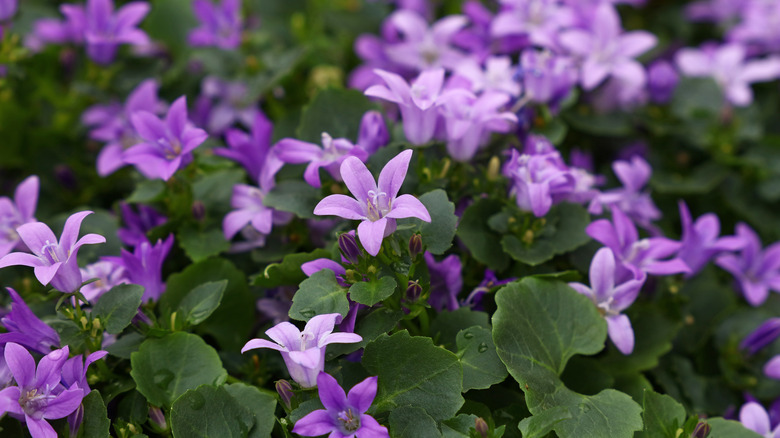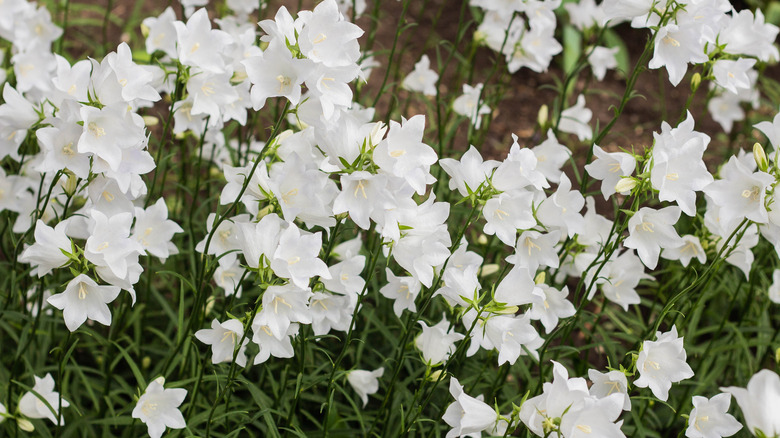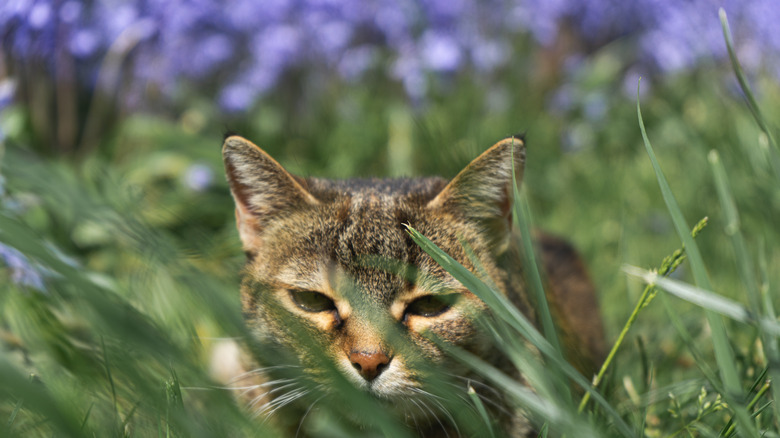Campanula Bellflower: Everything You Should Know Before Planting
Would your flower garden benefit from a cheerful pop of purple? Are you searching for flowers with a long bloom time and very little maintenance? Bellflower (scientific name Campanula) might be exactly what your garden has been missing! The perennial is named for the whimsical, bell-like shape of its blooms. It's a favorite choice for planting in cottage-style gardens.
Although purple is the most common shade, you can also find bellflowers in white, pink, or even a unique light blue, according to Gardening Know How. Most grow in clusters, with round leaves and thin stems. Even though the flowers are delicate, they can be heavy enough to cause the stems to bend, so it's not unusual to see bellflowers with a droopy appearance. Just keep in mind this likely isn't an indication of water issues (as droopiness commonly signals in other plants), and it's simply due to the thin, weak stems. Bellflowers are relatively easy to grow, are a lovely addition to both beds and garden borders, and will provide your garden a sweet pop of color all through spring and well into fall.
How to grow bellflowers
While it's true that bellflowers are low-maintenance in the grand scheme of the gardening world, that doesn't mean they're entirely hands-off. While they're not finicky, they still require certain conditions. Gardening Know How reports that if you live in USDA zone four or above, your climate should be a good fit for bellflowers. They do best in well-draining soil. Depending on your preference, you can grow them from seeds, rhizomes, or established plants purchased from a garden center. If you decide to plant seeds, hold off until any threat of frost has passed. You'll also want to make sure the seedlings don't dry out, so keep them moist until planting.
When planting bellflowers, the spacing will depend on which variety of bellflower you choose, as some have very different growing habits. Be sure to read the care tag of your particular plant to ensure you space them correctly.
How to use bellflowers in the garden
Bellflowers are available in numerous sizes and colors, so you can easily find one that perfectly suits your garden's aesthetic. According to Gardenia, tall varieties are available and make excellent cut flowers. You can also choose varieties that mound and creep. These work especially well in rock gardens or placed along the perimeter as edging plants.
Are you thinking about using them in a pot or hanging basket? They're a great choice, as their blooms will delicately spill over the sides, giving the arrangement a lovely, effortless appearance. However, you'll likely want to choose a dwarf variety, so it doesn't outgrow the container. Gardening Know How explains that the dwarfs only grow about 3 inches tall, and their spread maxes out around 15 inches. They're especially attractive with companion plants like geraniums, coral bells, roses, and columbine. But don't let this list limit you. Their lovely colors and shape allow for endless pairing options.
How to care for bellflowers
As mentioned above, bellflowers are relatively low-maintenance as long as their basic needs are met. If you want to guarantee plentiful blooms, choose a planting location that gets full sun. They prefer well-draining soil, and you'll need to keep them sufficiently watered (but not soggy) until they're established, says Gardening Know How. Once they're mature, they'll be pretty tolerant of infrequent watering or drought. Additionally, you don't need to worry about amending your soil because bellflowers aren't picky. They'll thrive in practically any pH level.
Besides proper sunshine and watering, you can extend the life of your flowers by deadheading the spent blooms to encourage another round of growth. If you want to add additional nutrients, feel free to do so, but know it's not required. Garden Lovers Club suggests applying a balanced fertilizer one time in the spring and again partway through the summer. Finally, add a layer of mulch to keep the soil cool and free of weeds.
Varieties of bellflowers
According to Garden Lovers Club, there are hundreds of varieties of bellflowers, so you shouldn't have any difficulty finding the perfect type for your garden. They're generally native to North America and originated as forest flowers. Here are a few of the most popular varieties:
*Peach-leaved bellflower (scientific name Campanula persicifolia) comes in shades of white and light purple and reaches heights of 3 feet.
*Korean bellflower (scientific name Campanula takesimana) has longer, lantern-shaped blossoms in a pinkish white shade.
*Serbian bellflower (scientific name Campanula poscharskyana) is a mounding variety that can spread to 5 feet wide with bluish-purple blooms.
*Milky bellflower (scientific name Campanula lactiflora) takes a bushy form and can grow to 5 feet in height with flowers that range from white to light blue.
*Dalmatian bellflower (scientific name Campanula portenschlagiana) does not have spots like its name suggests, but it produces rich purple blooms and can be used as a ground cover.
Are bellflowers toxic?
If you've got pets who love to dig in your garden or kids who are curious about plant life, you can breathe a sigh of relief because your bellflowers aren't toxic. The University of California confirms that they aren't harmful to humans, while Gardeners World verifies that they don't pose any threat to pets.
When it comes to other common issues with bellflowers, most can be avoided. UK House Plants says that the number-one issue is overwatering. If the leaves of your plant are starting to turn yellowish-brown or develop soft spots, these are telltale signs that you're watering too much. On the flip side, if the leaves begin to curl and feel crispy to the touch, this means they need a healthy watering.
Another issue that some gardeners face is the spread of bellflowers. When the plant is healthy and happy, it can spread quickly and easily, threatening to take over the garden patch where it resides. Stay on top of dividing and transplanting to avoid this issue.
Overall, bellflowers are laid-back perennials that bring charm and color to your garden without requiring much fuss or care. They're a great addition to any landscape design.
